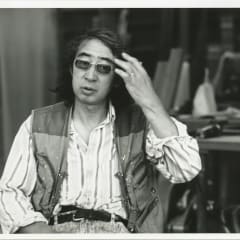Kishio Suga
Click here to book your visit.
Mendes Wood DM São Paulo is pleased to present the first solo exhibition of the seminal Japanese artist Kishio Suga at Casa Iramaia. As one of the pivotal figures in post-war Japan, Suga has spent more than five decades creating works that feature arrangements of natural and industrial elements such as rocks, branches, metal, and paper, aiming to unveil things as they are, granting the artist rhythmic freedom and compositional liberty over these elements.
Suga's artistic practice started in 1968, when he began crafting ephemeral installations using natural and industrial materials like wood, metal, wire, and concrete. Swiftly garnering acclaim for his creations and writings on conceptualism, Suga introduced a discordant yet defined structure of raw materials into gallery spaces, seeking to uncover the reality of "mono" (things/materials) and the "jōkyō" (situation) that binds them together. Through these installations and influential essays, Suga emerged as a pivotal theorist within a loose coalition of like-minded artists, later recognized as Mono-ha (School of Things). Although fleeting, this movement marked a significant milestone in post-war Japanese art history, echoing the development of Land Art, Arte Povera, and Supports/Surfaces in the United States and Europe, while remaining rooted in a distinctively Japanese intellectual and cultural milieu.
Featuring predominantly wall works, the exhibition lays bare the artist's interpretation of boundaries and positions. The geometric notions in Suga's work unveil a primordial essentiality in his compositional intentions. Suga explores states of concurrency and situations shaped by their construction, arrangement, and visibility. By eschewing complex production methods and manufacturing intricacies, he encourages discourse about things in their unadorned state, transforming the essence of the artwork by disengaging materials from their customary contexts.
Kishio Suga was born in Morioka, Iwate Prefecture, in 1944, and currently resides and works in Ito, Shizuoka Prefecture.
His solo exhibitions include:He Art Museum, Foshan, China (2024); Iwate Museum of Art, Morioka (2021); Spiral Garden, Tokyo (2021); Mendes Wood DM, Brussels (2022); Pirelli Hangar Bicocca, Milan (2016); Dia: Chelsea, New York (2016); and the Museum of Contemporary Art, Tokyo (2015). He is frequently featured in global survey exhibitions. A re-creation of his groundbreaking outdoor installation "Law of Situation" (1971) was showcased at the 57th Venice Biennale in the Gaggiandre shipyard (2017), and his work was part of "Japanorama: New Vision on Art since 1970" at the Centre Pompidou Metz (2018).
Recent group exhibitions include: “Inhabiting Time,” Pinault Collection, Laennec Chapel, Paris (2023); “Sam Francis and Japan: Emptiness Overflowing,” Los Angeles County Museum of Art, Los Angeles (2022); “Collection: The Aesthetics of Contemporary Japan,” National Museum of Art, Osaka (2021); "The Emergence of the Contemporary: Avant-Garde Art in Japan 1950–1970," Imperial Palace, Rio de Janeiro (2016); "Karla Black and Kishio Suga: A New Order" at the Scottish National Gallery of Modern Art, Edinburgh (2016); "Prima Materia," Punta della Dogana, Venice (2013); "Parallel Views: Italian and Japanese Art from the 1950s, 60s, and 70s," The Warehouse, Dallas (2013); and "Tokyo 1955-1970: A New Avant-Garde," Museum of Modern Art, New York (2012).
His work is housed in numerous institutional collections, including the Centre Pompidou-Metz, Metz, France; Dallas Museum of Art, Dallas; Dia Art Foundation, New York; Glenstone Foundation, Potomac, Maryland; Guggenheim Abu Dhabi, Abu Dhabi; Long Museum, Shanghai; M+, Hong Kong; Museum of Contemporary Art, Tokyo; Museum of Modern Art, New York; National Museum of Art, Osaka, Japan; National Museum of Modern Art, Tokyo; Pinault Collection, Venice; Rachofsky Collection, Dallas; Tate Modern, London; Tokyo Metropolitan Art Museum, Tokyo; and the Yokohama Museum of Art, Yokohama, Japan.


























